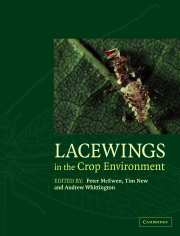Book contents
- Frontmatter
- Contents
- List of contributors
- Preface
- PART 1 Lacewing systematics and ecology
- PART 2 Lacewings in crops
- PART 3 Principles
- PART 4 Case studies
- Introduction to Part 4
- CHAPTER 18 Micromus tasmaniae: a key predator on aphids on field crops on Australasia?
- CHAPTER 19 Preliminary notes on Mallada signatus (Chrysopidae) as a predator in field crops in Australia
- CHAPTER 20 An evaluation of lacewing releases in North America
- CHAPTER 21 Chrysoperla externa and Ceraeochrysa spp.: potential for biological control in the New World tropics and subtropics
- CHAPTER 22 Comparative plant substrate specificity of Iberian Hemerobiidae, Coniopterygidae, and Chrysopidae
- CHAPTER 23 Lacewings in Sardinian olive groves
- CHAPTER 24 Lacewing occurrence in the agricultural landscape of Pianura Padana
- CHAPTER 25 Lacewings and snake-flies in Piedmont vineyards (northwestern Italy)
- CHAPTER 26 Control of aphids by Chrysoperla carnea on strawberry in Italy
- CHAPTER 27 Artificial overwintering chambers for Chrysoperla carnea and their application in pest control
- CHAPTER 28 Lacewings in Andalusian olive orchards
- CHAPTER 29 The green lacewings of Romania, their ecological patterns and occurrence in some agricultural crops
- CHAPTER 30 Biological control with Chrysoperla lucasina against Aphis fabae on artichoke in Brittany (France)
- PART 5 Conclusion
- Taxonomic index
- General index
CHAPTER 18 - Micromus tasmaniae: a key predator on aphids on field crops on Australasia?
Published online by Cambridge University Press: 04 May 2010
- Frontmatter
- Contents
- List of contributors
- Preface
- PART 1 Lacewing systematics and ecology
- PART 2 Lacewings in crops
- PART 3 Principles
- PART 4 Case studies
- Introduction to Part 4
- CHAPTER 18 Micromus tasmaniae: a key predator on aphids on field crops on Australasia?
- CHAPTER 19 Preliminary notes on Mallada signatus (Chrysopidae) as a predator in field crops in Australia
- CHAPTER 20 An evaluation of lacewing releases in North America
- CHAPTER 21 Chrysoperla externa and Ceraeochrysa spp.: potential for biological control in the New World tropics and subtropics
- CHAPTER 22 Comparative plant substrate specificity of Iberian Hemerobiidae, Coniopterygidae, and Chrysopidae
- CHAPTER 23 Lacewings in Sardinian olive groves
- CHAPTER 24 Lacewing occurrence in the agricultural landscape of Pianura Padana
- CHAPTER 25 Lacewings and snake-flies in Piedmont vineyards (northwestern Italy)
- CHAPTER 26 Control of aphids by Chrysoperla carnea on strawberry in Italy
- CHAPTER 27 Artificial overwintering chambers for Chrysoperla carnea and their application in pest control
- CHAPTER 28 Lacewings in Andalusian olive orchards
- CHAPTER 29 The green lacewings of Romania, their ecological patterns and occurrence in some agricultural crops
- CHAPTER 30 Biological control with Chrysoperla lucasina against Aphis fabae on artichoke in Brittany (France)
- PART 5 Conclusion
- Taxonomic index
- General index
Summary
INTRODUCTION
The Australian Hemerobiidae are largely endemic, with many of the 34 recorded species (New, 1988) not known elsewhere. Micromus tasmaniae (Walker) is by far the most abundant and widespread hemerobiid in Australia and New Zealand (where it is presumed indigenous, though possibly originating from Australia: Wise, 1992), and has attracted attention as the most frequent lacewing on low vegetation, including common occurrence on a variety of field crops. Its predominance is evident in several surveys noted below, and as New Zealand lacks native Chrysopidae on crops, it has attracted attention there as the lacewing occurring in agricultural systems. It is, likewise, often abundant in Australia. For example, in suction trap catches near Melbourne, Victoria, over three years it comprised 3847/4080 (94.3%) of all Hemerobiidae (New, 1984). Most other Australian hemerobiids are relatively scarce in such collections, and only Drepanacra binocula (Newman) is otherwise likely to be familiar, even to many entomologists. That species also occurs in New Zealand, and like the other New Zealand Micromus species, M. bifasciatus Tillyard, is relatively scarce and not regarded as a significant component of the crop fauna.
BIOLOGY
The two common Australasian hemerobiid species differ considerably in biology.Drepanacra binocula is predominantly arboreal and is a relatively specialised feeder on Psylloidea, whereas Micromus tasmaniae is a more generalised polyphagous feeder on arthropods of low vegetation, though it occurs also on shrubs and trees. The early stages were described by New & Boros (1984).
- Type
- Chapter
- Information
- Lacewings in the Crop Environment , pp. 388 - 394Publisher: Cambridge University PressPrint publication year: 2001
- 1
- Cited by



